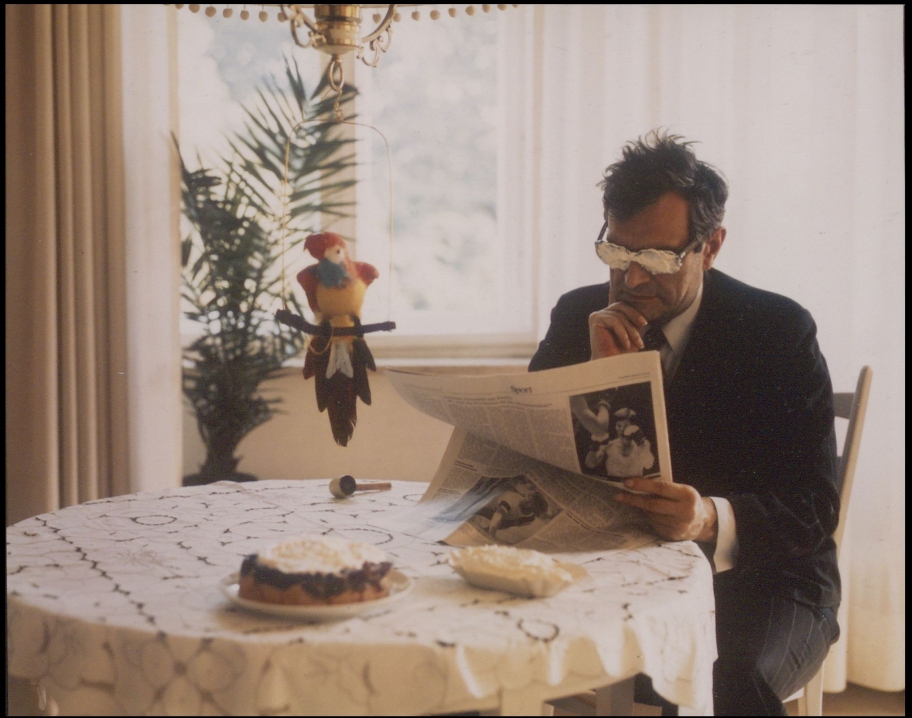France, Visual Arts, 1974
Daniel
Buren
Daniel Buren (b. 1938 in Boulogne-Billancourt near Paris) came to Berlin in July 1974 as a fellow of the DAAD Artists-in-Berlin Program (BKP). In the painter and sculptor’s analytical and conceptual practice, “awning stripes” have become his trademark: he applies these 8.7 (+/– 0.3) cm-wide stripes of different colors, usually alternating with stripes of white, to a wide range of forms and materials. Inspired by the détournement strategy employed by the Situationists, Buren chooses not to place his pieces as autonomous works of art in neutral white spaces, but instead integrates them into existing architectural situations that are usually overlooked by the established art world. He also installs his works in public spaces—for example as part of an action in various locations, including a building site fence, for the exhibition Position – Proposition at Galerie Konrad Fischer in Düsseldorf in 1968. Buren’s contribution to documenta 5 in 1972 was Exposition d’une exposition: Une pièce en sept tableaux (Exhibition of an Exhibition. A Work in Seven Pieces),a site-specific work in which white paper printed with vertical white stripes provided a “backdrop” for the works of other, mainly American artists; these included works by the photorealists and a Flag painting by Jasper Johns. In this way, attention was drawn from the object to the underlying structure, and at the same time the historical distance of both works was emphasized. With this piece, however, Buren was also criticizing the disempowerment of artists by exhibition organizers and curators who considered themselves to be artists, as he elucidated in “Exhibition of an Exhibition,” his textual contribution to the catalogue that accompanied documenta 5.
The artistic highlight of Buren’s stay in Berlin was doubtless the regatta that took place on Wannsee Lake on September 20, 1975, under the heading Voile/Toile – Segel/Leinwand. 9 Arbeiten von Daniel Buren, and was organized by the Artists-in-Berlin Program in partnership with Galerie Folker Skulima. Nine Optimist-class sailboats were fitted with sails Buren had designed—the canvas was painted white with stripes in a second color—and were cast off into the Havel river at Insel Schwanenwerder. The sails, which were colored green (2x), yellow (2x), blue (2x), red (1x), orange (1x), and brown (1x), had been produced by a sail manufacturer in Bremerhaven using alternating strips of colored nylon that were cut to fit the masts of the Optimist sailboats. Due to the properties of the material and the sail, the width of the stripes—8.1 cm—deviated slightly from Buren’s standard format. The two white stripes at the outer edges of the sails were also painted over with white acrylic. The small boats were then sailed by children aged between 8 and 13 in a regatta on Wannsee Lake—Buren deliberately chose this location as a well-known public place and leisure site in Berlin. The sails were subsequently exhibited at the Akademie der Künste in West Berlin; they were thus returned to the art context and, as “canvas that has sailed off” (Buren), were removed from their place of origin (the boat and the lake). A catalogue was published to accompany the public performance and the exhibition. Further presentations of Toile/Voile – Voile/Toile have taken place in Geneva, Lucerne, Villeneuve d’Ascq, Lyon-Villeurbanne, Tel Aviv, Seville, and Grasmere.
For the second edition of Aktionen der Avantgarde – ADA 2, organized by the Neuer Berliner Kunstverein in collaboration with the Artists-in-Berlin Program and Berliner Festwochen and presented on September 26–30, 1974, Buren installed large-format ADA posters with green and white, orange and white, and gray and white stripes at the intersection of Kurfürstendamm and Fasanenstrasse. Daniel Buren participated in documenta 5, 6, and 7 (1972, 1977, and 1982) and took place several times in the Venice Biennale between 1972 and 2007.
Text: Eva Scharrer
Translation: Jacqueline Todd



